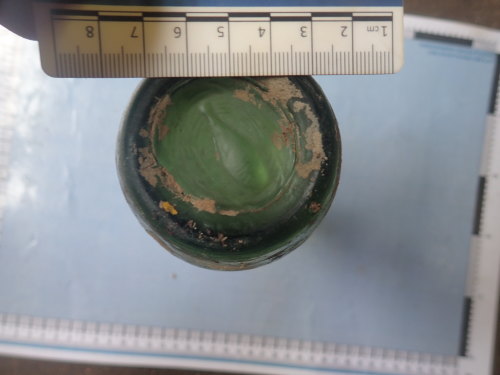
Image use policy
Our images can be used under a CC BY attribution licence (unless stated otherwise).
BOTTLE
Unique ID: MAS-F100103
Object type certainty: Certain
Workflow
status: Published ![]()
This flat-based Hamilton, or 'torpedo' bottle stands 240 mm high, with a 64-mm wide base and is approximately 90 mm wide at the waist. It has a 'bottle logo' embossed on its base. There are possibly other text/numerals that have since worn away. The bottle shows moulding scars on the base and sides. It has a crown top finish.
The egg-shaped bottle was first patented by William Francis Hamilton in 1814, the idea being that the bottle had to be stored on its side to keep the cork wet and ensuring a good seal on the reusable bottle. In around 1870, the flat based egg or Hamilton bottle was introduced. Following the 'blob top' finish being replaced by the crown top and cork sometime after 1892, when this cap design was patented, the design became more popular. This was because the bottles could now be reliably stored upright without cork shrinkage and a leaky seal causing loss of the carbonated gas. This is recognisable on this bottle by the beaded rim that the metal cap fitted over. These are also generally c.25mm in diameter. The cap would have been metal with a cork lining. This, however, lead to the decline in the popularity of torpedo bottles as it made them no longer necessary (Lucas, 2010).
The mould scar travels up the neck to the lip of the bottle and this would suggest that it was manufactured around 1910 on a semi or fully automated bottle making machine, near to the end of their popularity. The 'bottle logo' on the base is probably the manufactures logo, however, several manufacturers used the same logo as their mark and therefore it has not now been possible to isolate its exact point of manufacture. The bottles were extensively exported from the U.K. and are therefore found around the world, but particularly in the former colonies and North America.
Class:
BOTTLE
Sub class: Food and liquid storage container
Subsequent actions
Current location of find: With finder
Subsequent action after recording: Submitted as wreck to the Receiver of Wreck
Chronology
Broad period: MODERN
Period from: MODERN
Period to: MODERN
Dimensions and weight
Quantity: 1
Height: 240 mm
Diameter: 90 mm
Discovery dates
Date(s) of discovery: Wednesday 23rd August 2017
Personal details
Found by: This information is restricted for your login.
Materials and construction
Primary material: Glass
Manufacture method: Moulded
Completeness: Complete
Spatial coordinates
4 Figure: TQ4400
Four figure Latitude: 50.78170298
Four figure longitude: 0.04126088
1:25K map: TQ4400
1:10K map: TQ40SW
Display four figure position on What3Words
Unmasked grid reference accurate to a 1 metre square.
References cited
- Lucas, V.,, 2010 Hightown, Castleford, West Yorkshire. An Assessment of Bottle Glass from the Hightown Glasshouse. Portsmouth : English Heritage, ,
Similar objects

Find number: MAS-D100072
Object type: BOTTLE
Broadperiod: NINETEENTH CENTURY
One Hamilton bottle also known as a torpedo or egg bottle. These bottles are named after their English inventor, William Francis Hamilton who …
Workflow: Published![]()

Find number: MAS-D100071
Object type: BOTTLE
Broadperiod: NINETEENTH CENTURY
Three aqua coloured glass bottles with tooled lips; for foodstuffs or other household goods; probably dating to the 19th century.
These bottl…
Workflow: Published![]()

Find number: MAS-D100230
Object type: BOTTLE
Broadperiod: NINETEENTH CENTURY
Three bottles of blown glass. The frst two bottles are torpedo or Hamilton´s type bottle (Hamilton introduced this type of blow molding) from…
Workflow: Published![]()






